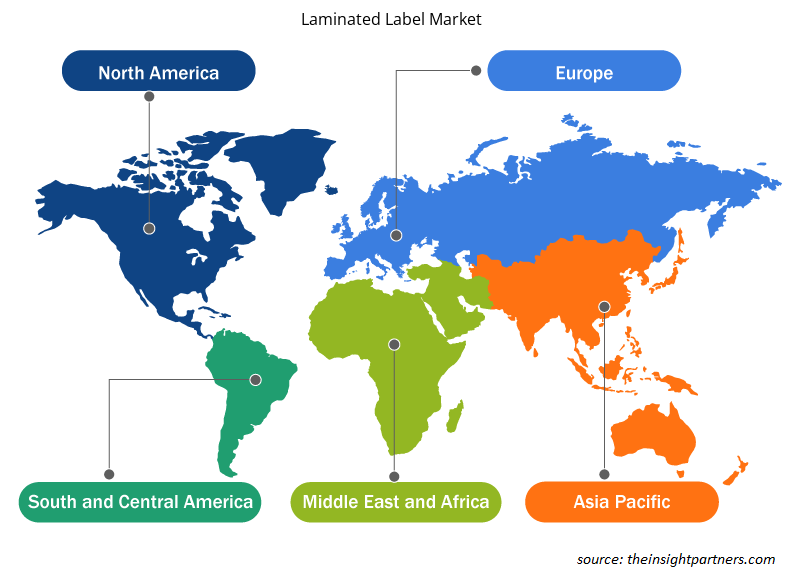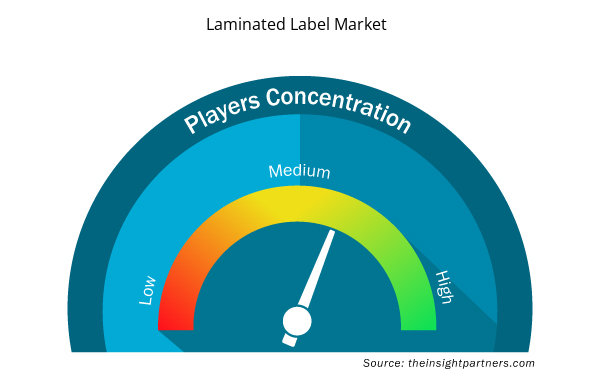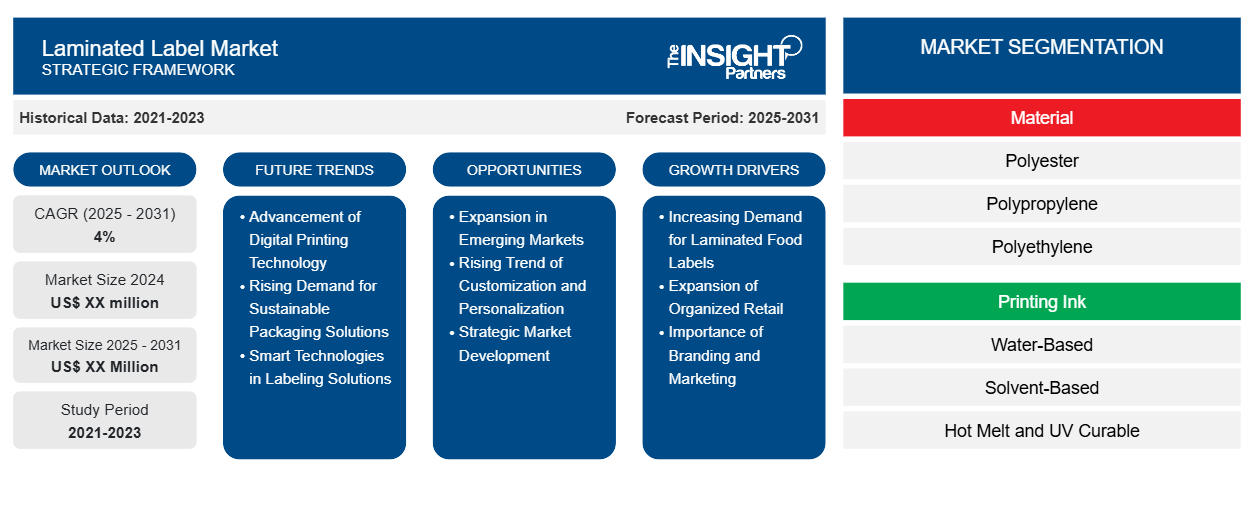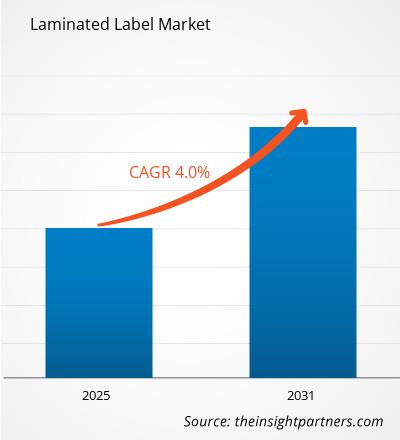预计 2023 年至 2031 年期间层压标签市场的复合年增长率为 4%,市场规模将从 2023 年的 XX 百万美元扩大到 2031 年的 XX 百万美元。
报告按材料(聚酯、聚丙烯、聚乙烯、乙烯基等)和印刷油墨(水基、溶剂型、热熔和紫外线固化)进行细分。报告进一步根据最终用途行业(食品和饮料、消费品、电子产品、个人护理和化妆品、药品等)进行分析。全球分析进一步细分为区域和主要国家。范围涵盖所有关键细分市场的全球、区域和国家层面的市场规模和预测。报告以美元为单位提供上述分析和细分的价值。报告提供了主要市场参与者的市场状况的关键统计数据,并提供了市场趋势和机会。
报告目的
The Insight Partners 的《层压标签市场》报告旨在描述当前形势和未来增长、主要驱动因素、挑战和机遇。这将为各种业务利益相关者提供见解,例如:
- 技术提供商/制造商:了解不断变化的市场动态并了解潜在的增长机会,从而能够做出明智的战略决策。
- 投资者:对市场增长率、市场财务预测以及整个价值链中存在的机会进行全面的趋势分析。
- 监管机构:监管市场政策和警察活动,旨在最大限度地减少滥用行为,维护投资者的信任和信心,维护市场的完整性和稳定性。
层压标签市场细分
材料
- 聚酯纤维
- 聚丙烯
- 聚乙烯
- 乙烯基及其他
印刷油墨
- 水基
- 溶剂型
- 热熔和紫外线固化
终端使用行业
- 食品和饮料
- 消费品
- 电子产品
- 个人护理和化妆品
- 医药及其他
地理
- 北美
- 欧洲
- 亚太
- 南美洲和中美洲
- 中东和非洲
地理
- 北美
- 欧洲
- 亚太
- 南美洲和中美洲
- 中东和非洲
定制此报告以满足您的需求
您可以免费定制任何报告,包括本报告的部分内容、国家级分析、Excel 数据包,以及为初创企业和大学提供优惠和折扣
- 获取此报告的关键市场趋势。这个免费样品将包括数据分析,从市场趋势到估计和预测。
层压标签市场增长动力
- 层压食品标签需求不断增长:食品和饮料行业特别喜欢层压标签。鉴于食品标签的详细规则和规定,这些制造商一直在寻找高质量、耐用的标签,这些标签可以承受水、热和摩擦等最恶劣的条件。由于层压标签具有耐磨性,产品的重要细节可以保证在产品使用过程中保持良好状态。随着越来越多的消费者倾向于购买已包装和加工的食品,预计层压标签市场将以惊人的速度增长。
- 有组织零售的扩张:零售和电子商务的扩张进一步加剧了层压标签市场的机会。向网上购物的转变增加了对标签的需求,特别是在产品品牌和货物运输过程中的识别方面。层压标签的范围不仅限于其功能用途,还扩展到商业促销活动。放宽对广告的限制,以及对通过互联网直接面向消费者销售的产品进行图形化、醒目和防篡改屏蔽标签的需求,正在刺激许多零售领域的活动。
- 品牌和营销的重要性:品牌和营销已成为当前市场上激励消费者购买商品的最重要因素之一。因此,公司已开始为其产品生产更好、更有吸引力的标签,以期击败竞争对手。层压标签外观精美,可以采用不同的颜色、结构和饰面,为整体包装增添色彩。这在化妆品、个人和家庭护理产品行业以及对层压标签解决方案的需求中更为明显。
层压标签市场未来趋势
- 数字印刷技术的进步:数字印刷技术的进步极大地影响了层压标签行业的转型。它有助于快速生产包含图像和鲜艳色彩的最小标牌集合。数字印刷为制造商为其需要任何类型标签的客户高效定制标签打开了大门。以很少或没有设置成本提供定制标签产品的可能性正在彻底改变这个市场,使其对小型企业和初创企业友好。
- 对可持续包装解决方案的需求不断增长:随着全球变暖问题日益成为议程上的重点,最传统的层压标签市场也倾向于生产新一代环保层压标签。越来越多的生产商开始着手解决先进可回收材料的问题,例如可降解薄膜和可生物降解胶水,以制造对自然危害较小的标签。解决这些问题不仅可以满足客户寻求更环保产品的需求,还可以满足当局对可持续性日益增长的需求。这反过来又增加了人们对在标签解决方案中添加可持续功能的关注和关注,从而加剧了层压标签解决方案市场的竞争。
- 标签解决方案中的智能技术:层压标签市场的一个新兴趋势是智能技术与标签解决方案的重叠。实施此类系统可以将包含二维码、NFC 标签或 RFID 芯片的智能标签覆盖在包装上,使品牌能够提供有关产品的信息,甚至与消费者互动。这为使用层压标签提供了附加价值,因为它们允许企业管理库存物品、维护产品记录和收集客户详细信息。随着智能技术的普及,使用层压标签实现其增强功能的机会也将增加。
层压标签市场机会
- 新兴市场的扩张:现在是层压标签制造商进军新领域的好时机,尤其是亚太、拉丁美洲和非洲。由于这些地区的城市化进程加快、人民经济状况改善以及中产阶级的崛起,这些地区对包装产品和有效标签系统的需求不断增加。通过适当的产品本地化和与当地经销商的合作,可以成功进入当地市场。
- 定制和个性化趋势日益明显:随着人们的品味和偏好不断向大规模定制和个性化产品转变,层压标签市场将受益匪浅。如今,我们越来越频繁地看到,品牌希望拥有独特的标签解决方案,这些解决方案应与其他解决方案区分开来,并与消费者产生显著联系。这对制造商来说是主要因素,他们可以提供可定制的选项,例如可变数据打印、不同的形状和纹理。这将有助于在消费市场中建立品牌忠诚度并协助品牌管理。
- 战略市场开发:层压标签制造商有很多扩展业务的可能性,例如通过并购或与涉及包装、物流或零售的公司建立战略联盟。例如,与包装公司或电子商务公司联手可能使公司能够提供一些包装服务,其中层压标签将包含在包装供应链中。通过面向这一特定群体,公司可以在当地市场获得更高的知名度,并根据趋势、发展和市场需求推广合适的产品。
层压标签市场区域洞察
Insight Partners 的分析师已详尽解释了预测期内影响层压标签市场的区域趋势和因素。本节还讨论了北美、欧洲、亚太地区、中东和非洲以及南美和中美洲的层压标签市场细分和地理位置。

- 获取层压标签市场的区域特定数据
层压标签市场报告范围
| 报告属性 | 细节 |
|---|---|
| 2023 年的市场规模 | XX 百万美元 |
| 2031 年市场规模 | XX 百万美元 |
| 全球复合年增长率(2023 - 2031) | 4% |
| 史料 | 2021-2022 |
| 预测期 | 2024-2031 |
| 涵盖的领域 | 按材质
|
| 覆盖地区和国家 | 北美
|
| 市场领导者和主要公司简介 |
|
层压标签市场参与者密度:了解其对业务动态的影响
层压标签市场正在快速增长,这得益于最终用户需求的不断增长,这些需求源于消费者偏好的不断变化、技术进步以及对产品优势的认识不断提高等因素。随着需求的增加,企业正在扩大其产品范围,进行创新以满足消费者的需求,并利用新兴趋势,从而进一步推动市场增长。
市场参与者密度是指在特定市场或行业内运营的企业或公司的分布情况。它表明在给定市场空间中,相对于其规模或总市场价值,有多少竞争对手(市场参与者)存在。
在层压标签市场运营的主要公司有:
- 3M 公司
- 艾利丹尼森公司
- 比米斯公司
- CCL Industries Inc. 5. Constantia Flexibles Group GmbH
- 康佛里斯控股公司
免责声明:上面列出的公司没有按照任何特定顺序排列。

- 获取层压标签市场顶级关键参与者概述
主要卖点
- 全面覆盖:报告全面涵盖了层压标签市场的产品、服务、类型和最终用户的分析,提供了整体概况。
- 专家分析:报告基于对行业专家和分析师的深入了解而编写。
- 最新信息:该报告涵盖了最新信息和数据趋势,确保了其与业务的相关性。
- 定制选项:此报告可以定制以满足特定客户要求并恰当地适应业务策略。
因此,关于层压标签市场的研究报告可以帮助引领解码和了解行业情景和增长前景。尽管可能存在一些合理的担忧,但本报告的总体优势往往大于劣势。
- 历史分析(2 年)、基准年、预测(7 年)及复合年增长率
- PEST 和 SWOT 分析
- 市场规模价值/数量 - 全球、区域、国家
- 行业和竞争格局
- Excel 数据集


- Emergency Department Information System (EDIS) Market
- Vision Guided Robotics Software Market
- Latent TB Detection Market
- Sandwich Panel Market
- Grant Management Software Market
- Artificial Intelligence in Defense Market
- Joint Pain Injection Market
- Toothpaste Market
- Identity Verification Market
- Virtual Pipeline Systems Market

Report Coverage
Revenue forecast, Company Analysis, Industry landscape, Growth factors, and Trends

Segment Covered
This text is related
to segments covered.

Regional Scope
North America, Europe, Asia Pacific, Middle East & Africa, South & Central America

Country Scope
This text is related
to country scope.
常见问题
Based on geography, Asia Pacific held the significant share of the laminated label market due to growth in the end-use industries
Advancement in digital printing technology is expected to be the key market trends
Based on end-use industry, consumer goods segment is expected to witness the fastest growth during the forecast period
Growth in the e-commerce and retail sector is driving the market growth
3M; Avery Dennison Corporation; CCL Industries; Lecta Adestor; Flexcon Company, Inc are some of the key players operating in the laminated label market
The Laminated Label Market is estimated to witness a CAGR of 4% from 2023 to 2031
Trends and growth analysis reports related to Chemicals and Materials : READ MORE..
1. 3M Company
2. Avery Dennison Corporation
3. Bemis Company, Inc.
4. CCL Industries Inc.
5 . Constantia Flexibles Group GmbH
6. Coveris Holdings S.A.
7. Flexcon Company, Inc.
8. R.R. Donnelley and Sons Company
9. Stickythings Limited
10. Torraspapel Adestor
The Insight Partners performs research in 4 major stages: Data Collection & Secondary Research, Primary Research, Data Analysis and Data Triangulation & Final Review.
- Data Collection and Secondary Research:
As a market research and consulting firm operating from a decade, we have published and advised several client across the globe. First step for any study will start with an assessment of currently available data and insights from existing reports. Further, historical and current market information is collected from Investor Presentations, Annual Reports, SEC Filings, etc., and other information related to company’s performance and market positioning are gathered from Paid Databases (Factiva, Hoovers, and Reuters) and various other publications available in public domain.
Several associations trade associates, technical forums, institutes, societies and organization are accessed to gain technical as well as market related insights through their publications such as research papers, blogs and press releases related to the studies are referred to get cues about the market. Further, white papers, journals, magazines, and other news articles published in last 3 years are scrutinized and analyzed to understand the current market trends.
- Primary Research:
The primarily interview analysis comprise of data obtained from industry participants interview and answers to survey questions gathered by in-house primary team.
For primary research, interviews are conducted with industry experts/CEOs/Marketing Managers/VPs/Subject Matter Experts from both demand and supply side to get a 360-degree view of the market. The primary team conducts several interviews based on the complexity of the markets to understand the various market trends and dynamics which makes research more credible and precise.
A typical research interview fulfils the following functions:
- Provides first-hand information on the market size, market trends, growth trends, competitive landscape, and outlook
- Validates and strengthens in-house secondary research findings
- Develops the analysis team’s expertise and market understanding
Primary research involves email interactions and telephone interviews for each market, category, segment, and sub-segment across geographies. The participants who typically take part in such a process include, but are not limited to:
- Industry participants: VPs, business development managers, market intelligence managers and national sales managers
- Outside experts: Valuation experts, research analysts and key opinion leaders specializing in the electronics and semiconductor industry.
Below is the breakup of our primary respondents by company, designation, and region:

Once we receive the confirmation from primary research sources or primary respondents, we finalize the base year market estimation and forecast the data as per the macroeconomic and microeconomic factors assessed during data collection.
- Data Analysis:
Once data is validated through both secondary as well as primary respondents, we finalize the market estimations by hypothesis formulation and factor analysis at regional and country level.
- Macro-Economic Factor Analysis:
We analyse macroeconomic indicators such the gross domestic product (GDP), increase in the demand for goods and services across industries, technological advancement, regional economic growth, governmental policies, the influence of COVID-19, PEST analysis, and other aspects. This analysis aids in setting benchmarks for various nations/regions and approximating market splits. Additionally, the general trend of the aforementioned components aid in determining the market's development possibilities.
- Country Level Data:
Various factors that are especially aligned to the country are taken into account to determine the market size for a certain area and country, including the presence of vendors, such as headquarters and offices, the country's GDP, demand patterns, and industry growth. To comprehend the market dynamics for the nation, a number of growth variables, inhibitors, application areas, and current market trends are researched. The aforementioned elements aid in determining the country's overall market's growth potential.
- Company Profile:
The “Table of Contents” is formulated by listing and analyzing more than 25 - 30 companies operating in the market ecosystem across geographies. However, we profile only 10 companies as a standard practice in our syndicate reports. These 10 companies comprise leading, emerging, and regional players. Nonetheless, our analysis is not restricted to the 10 listed companies, we also analyze other companies present in the market to develop a holistic view and understand the prevailing trends. The “Company Profiles” section in the report covers key facts, business description, products & services, financial information, SWOT analysis, and key developments. The financial information presented is extracted from the annual reports and official documents of the publicly listed companies. Upon collecting the information for the sections of respective companies, we verify them via various primary sources and then compile the data in respective company profiles. The company level information helps us in deriving the base number as well as in forecasting the market size.
- Developing Base Number:
Aggregation of sales statistics (2020-2022) and macro-economic factor, and other secondary and primary research insights are utilized to arrive at base number and related market shares for 2022. The data gaps are identified in this step and relevant market data is analyzed, collected from paid primary interviews or databases. On finalizing the base year market size, forecasts are developed on the basis of macro-economic, industry and market growth factors and company level analysis.
- Data Triangulation and Final Review:
The market findings and base year market size calculations are validated from supply as well as demand side. Demand side validations are based on macro-economic factor analysis and benchmarks for respective regions and countries. In case of supply side validations, revenues of major companies are estimated (in case not available) based on industry benchmark, approximate number of employees, product portfolio, and primary interviews revenues are gathered. Further revenue from target product/service segment is assessed to avoid overshooting of market statistics. In case of heavy deviations between supply and demand side values, all thes steps are repeated to achieve synchronization.
We follow an iterative model, wherein we share our research findings with Subject Matter Experts (SME’s) and Key Opinion Leaders (KOLs) until consensus view of the market is not formulated – this model negates any drastic deviation in the opinions of experts. Only validated and universally acceptable research findings are quoted in our reports.
We have important check points that we use to validate our research findings – which we call – data triangulation, where we validate the information, we generate from secondary sources with primary interviews and then we re-validate with our internal data bases and Subject matter experts. This comprehensive model enables us to deliver high quality, reliable data in shortest possible time.


 获取此报告的免费样本
获取此报告的免费样本